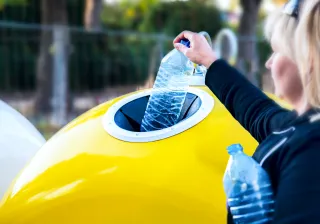What is plastic? In the light of recent discussions, you would think that there was already a textbook definition of plastic, i.e. it is a problem.
In less definitive terms, plastic could also be defined as follows: plastic is almost all things at once. It can be a problem, like any other material, if it ends up in the wrong place. But above all, when used correctly, it is a highly versatile and, contrary to public perceptions, environmentally friendly material, as long as it is not dumped in the natural environment.
This text is an introduction to the VTT blog series on plastics in the circular economy. Welcome to taking a glimpse into the world of plastics, through the eyes of a materials research scientist!
A small dose of polymer chemistry
Let’s explore a few molecular-level terms as a basis for learning about plastic. Put simply, plastic material consists of a block of polymer chains. These chains are further composed of basic materials called monomers. The process of combining monomers into long polymer chains is known as polymerisation; the end result is, of course, a polymer.
A polymer becomes a plastic when it is combined with additives, which may form a large proportion of the material. The characteristics of plastic products vary due to the huge range of monomers, their combinations, polymerisation conditions, additives and the processing methods used.
End product can be fossil or not
Most plastics are currently produced from fossil raw materials. These raw materials are a by-product of activities such as oil refining: plastic production capacity is therefore highly dependent on oil production volumes. The transition away from fossil-based plastics is an important long-term objective, which will support the key climate-friendly goal of abandoning the use of fossil fuels altogether.
Plastics can also be manufactured from renewable raw materials. Such bio-based plastics can serve as equivalents to oil-based ones: their monomers are similar to those refined by the petroleum industry, but the raw materials used in the monomers are renewable. The characteristics of such plastics are similar to those of the equivalent oil-based plastics. An example is sugarcane-based polyethylene (PE), which has been introduced in Lego building blocks representing plants. Bio-based plastics can also be prepared from materials such as starch or lactic acid, which provide a biodegradable final product. We take a closer look at bioplastics in the second part of the blog
Rockets made from granules
Plastic is usually transported from the manufacturer to the processor in the form of small plastic granules. The processor processes the granules by melting and moulding them to form large items such as storage tanks and car parts, films such as bags and covers, or long pieces such as pipes and profiles.
Plastic is unique when in use, due to its lightness combined with other adaptable features. For example, fuel is saved in road and air transport, and even in spacecraft, by using light and tough plastic composites instead of metallic parts. In packaging, in particular, replacing glass with plastic lightens loads and reduces the need for packaging material as a whole, when no additional protection against breakage is required.
At the end of the product lifecycle
Recent public discussions have labelled plastic as a disposable material. However, plastic is also used for long-lasting applications such as pipes and building blocks. It is estimated that a third of all plastic products manufactured between 1950 and 2015 were still in use in 2015.
Several alternative final destinations are possible at the end of a plastic product’s lifecycle. In accordance with the circular economy model, material recycling is the most effective way of using resources. We discuss the recycling of plastics in more detail in the third part of the blog series, and explore the most common consumer-driven business models for the circular economy in part four.
Plastic can be recycled both mechanically and chemically, depending on the properties of the initial material and the requirements of the finished product. Chemical recycling is one of the techniques of the new plastic economy. This and other visions of the future are discussed in the final, fifth part of the blog series.
Plastic is evolving, the definition is becoming blurred
What, ultimately, is plastic? This is difficult to answer because the brief definition of plastics, the synthetic polymer with additives, covers a wide range of types of plastic and applications.
In terms of material technology, we are on the brink of a new era. Material innovations, such as Paptic, combine the properties of plastics and fibre products, thereby broadening our ideas about both types of material. We need new, more descriptive terms for these new material solutions.
On the other hand, the plastics contained in some products may have been deliberately downplayed, which is understandable as long as the general perception of plastic remains narrow and negative in so many respects. For example, ‘bio-based’, ‘biodegradable’, and ‘conductive’ are adjectives seldom associated with plastics, but they are now possible attributes of the material. Product descriptions should go beyond the division between plastic/plastic-free, because the fact that a product is or is not plastic does not ultimately tell the consumer anything about its properties or raw materials.
What can my company do?
VTT wants to promote the responsible use of plastic and the new plastic economy together with businesses, consumers and other stakeholders. Means of doing so might involve the development of circular economy concepts and sustainable, high-performance material solutions. For example, new innovations could be based on VTT’s extensive polymer and composite processing facility in Tampere.









